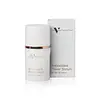What's inside
What's inside
 Key Ingredients
Key Ingredients

 Benefits
Benefits

 Concerns
Concerns

 Ingredients Side-by-side
Ingredients Side-by-side

Water
Skin ConditioningGlycerin
HumectantPropylene Glycol
HumectantPolysorbate 20
EmulsifyingSodium Ascorbyl Phosphate
AntioxidantCarbomer
Emulsion StabilisingSebacic Acid
BufferingNiacinamide
SmoothingRetinol
Skin ConditioningPhytic Acid
Tetrahexyldecyl Ascorbate
AntioxidantAllantoin
Skin ConditioningAlpha-Arbutin
AntioxidantCamellia Sinensis Leaf Extract
AntimicrobialRetinal
Skin ConditioningAscorbic Acid
AntioxidantCeramide NP
Skin ConditioningOctadecenedioic Acid
EmulsifyingPhospholipids
Skin ConditioningFerulic Acid
AntimicrobialOlive Glycerides
EmulsifyingSalicylic Acid
MaskingCaprylic/Capric Triglyceride
Masking10-Hydroxydecanoic Acid
Skin Conditioning1,10-Decanediol
SolventTriethanolamine
BufferingCyclohexane
SolventButylene Glycol
HumectantMethylparaben
PreservativePropylparaben
PreservativeBHT
AntioxidantBHA
AntioxidantPotassium Sorbate
PreservativeSodium Benzoate
MaskingWater, Glycerin, Propylene Glycol, Polysorbate 20, Sodium Ascorbyl Phosphate, Carbomer, Sebacic Acid, Niacinamide, Retinol, Phytic Acid, Tetrahexyldecyl Ascorbate, Allantoin, Alpha-Arbutin, Camellia Sinensis Leaf Extract, Retinal, Ascorbic Acid, Ceramide NP, Octadecenedioic Acid, Phospholipids, Ferulic Acid, Olive Glycerides, Salicylic Acid, Caprylic/Capric Triglyceride, 10-Hydroxydecanoic Acid, 1,10-Decanediol, Triethanolamine, Cyclohexane, Butylene Glycol, Methylparaben, Propylparaben, BHT, BHA, Potassium Sorbate, Sodium Benzoate
Alternatives
Ingredients Explained
These ingredients are found in both products.
Ingredients higher up in an ingredient list are typically present in a larger amount.
Glycerin is already naturally found in your skin. It helps moisturize and protect your skin.
A study from 2016 found glycerin to be more effective as a humectant than AHAs and hyaluronic acid.
As a humectant, it helps the skin stay hydrated by pulling moisture to your skin. The low molecular weight of glycerin allows it to pull moisture into the deeper layers of your skin.
Hydrated skin improves your skin barrier; Your skin barrier helps protect against irritants and bacteria.
Glycerin has also been found to have antimicrobial and antiviral properties. Due to these properties, glycerin is often used in wound and burn treatments.
In cosmetics, glycerin is usually derived from plants such as soybean or palm. However, it can also be sourced from animals, such as tallow or animal fat.
This ingredient is organic, colorless, odorless, and non-toxic.
Glycerin is the name for this ingredient in American English. British English uses Glycerol/Glycerine.
Learn more about GlycerinPolysorbate 20 is made by combining ethoxylation of sorbitan, ethylene oxide, and lauric acid. It is a mild cleansing agent, surfactant, and emulsifier.
As a surfactant, it helps collect dirt and oils for washing. Emulsifiers prevent oils and water from separating.
Polysorbate 20 also adds scent to a product. Since it is made using sorbitol, it has a sweet scent. Sorbitol can also be found in fruits such as apples and peaches.
The lauric acid used to create Polysorbate 20 is often derived from coconuts.
Polysorbate 20 may not be fungal acne safe.
Learn more about Polysorbate 20Tetrahexyldecyl Ascorbate (THD) is a stable and oil-soluble form of Vitamin C.
THD is special in that it has the ability to travel deeper into skin than traditional ascorbic acid while maintaining the same skin benefits (double win!).
Because it’s oil-soluble, THD dives deep into your skin’s fatty layers (think ceramides and cholesterol) to fight off the kind of free radicals that mess with your skin barrier. This makes it a great pair with water-based vitamin C (ascorbic acid) that mainly works on the surface.
Even at just 0.1%, THD is already showing great antioxidant activity. When used up to 2%, it helps keep your skin happy and calm, especially when it’s stressed from pollution or sun.
Want to fade dark spots or tackle hyperpigmentation? You’ll want 5% or more. Pairing it with brightening buddies like niacinamide or licorice root gives even better results. One study even used 30% THD with other brighteners and saw real results on stubborn discoloration, even in melasma-prone skin.
A note on THD: It’s has a slightly silky, oily texture and usually shows up colorless or pale yellow (though the exact shade can vary by supplier).
While you can sneak it into water-based formulas, it really shines when paired with silicones or oils, which help your skin soak it up better.
THD is pretty stable, but it’s still vulnerable to degradation like ascorbic acid. Too much light or heat (above 113°F / 45°C) can break it down over time. Go for dark and opaque packaging that keeps it safe and shady!
Read more about other types of Vitamin C:
Learn more about Tetrahexyldecyl Ascorbate